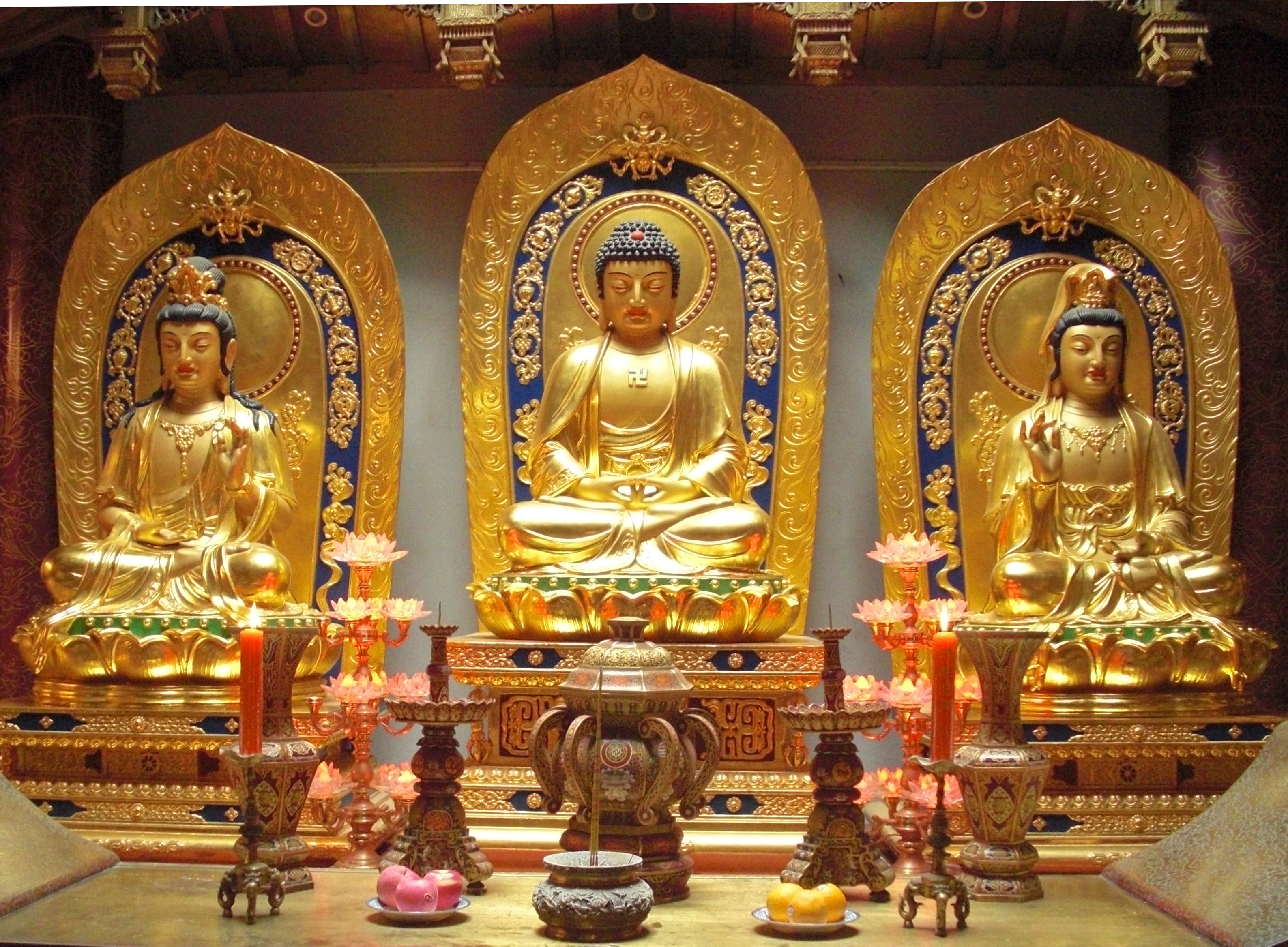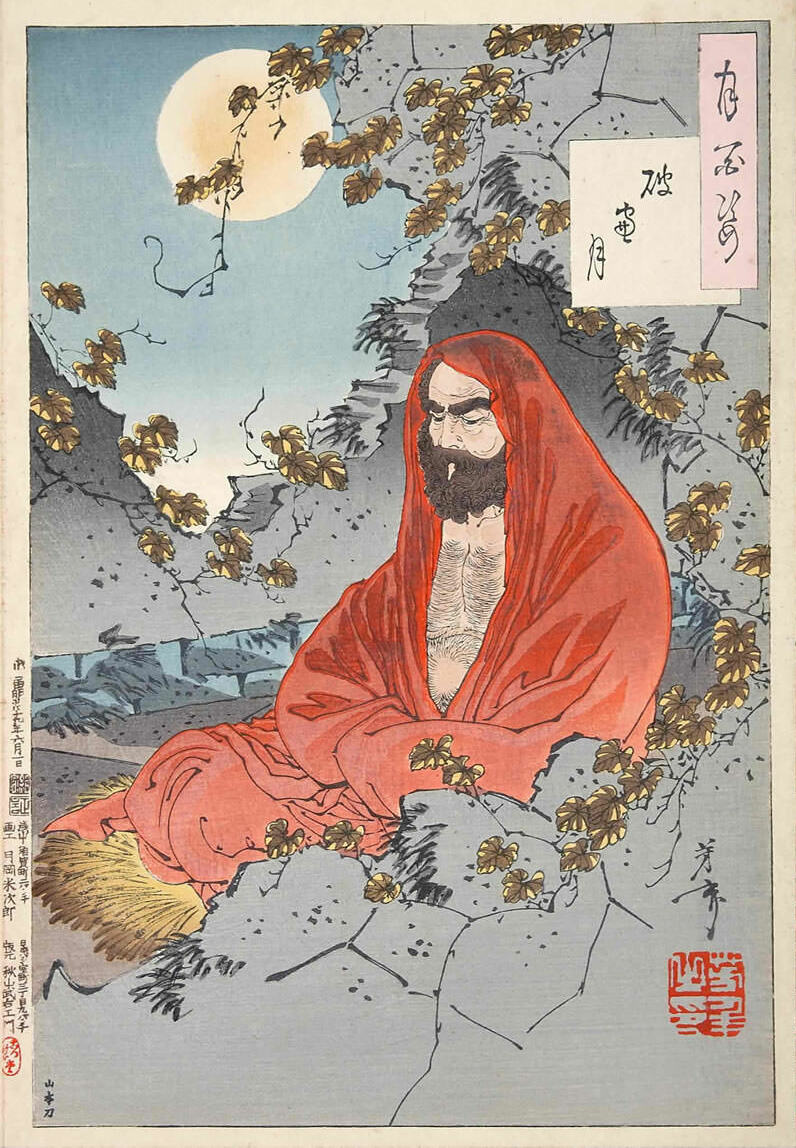|
Platform Sutra Of The Sixth Patriarch
The ''Platform Sutra of the Sixth Patriarch'' ( or simply: ''Tánjīng'') is a Chan Buddhist scripture that was composed in China during the 8th to 13th century. The "platform" (施法壇) refers to the podium on which a Buddhist teacher speaks. Its key themes are the direct perception of one's true nature, and the unity in essence of '' śīla'' (conduct), '' dhyāna'' (meditation) and '' prajñā'' (wisdom). The text centers on teachings and stories ascribed to the sixth Chan patriarch Huineng. It contains the well-known story of the contest for the succession of Hongren (enlightenment by the non-abiding), and discourses and dialogues attributed to Huineng. The text attributes its recollection to Fa-hai, but was probably written within the so-called Oxhead school, which existed along with the East Mountain School and Shenhui's Southern School. The text attempts to reconcile the so-called Northern School with its alleged gradual enlightenment teachings, and the so-called ... [...More Info...] [...Related Items...] OR: [Wikipedia] [Google] [Baidu] |
Chan Buddhist
Chan (; of ), from Sanskrit ''dhyāna in Buddhism, dhyāna'' (meaning "meditation" or "meditative state"), is a Chinese school of Mahayana, Mahāyāna Buddhism. It developed in China from the 6th century Common Era, CE onwards, becoming especially popular during the Tang dynasty, Tang and Song dynasty, Song dynasties. Chan is the originating tradition of Zen Buddhism (the Japanese pronunciation of the same Chinese characters, character, which is the most commonly used English name for the school). Chan Buddhism spread from China south to Vietnam as Vietnamese Thiền, Thiền and north to Korea as Korean Seon, Seon, and, in the 13th century, east to Japan as Japanese Zen. History The historical records required for a complete, accurate account of early Chan history no longer exist. Periodisation The history of Chan in China can be divided into several periods. Zen, as we know it today, is the result of a long history, with many changes and contingent factors. Each perio ... [...More Info...] [...Related Items...] OR: [Wikipedia] [Google] [Baidu] |
Prajnaparamita
A Tibetan painting with a Prajñāpāramitā sūtra at the center of the mandala Prajñāpāramitā ( sa, प्रज्ञापारमिता) means "the Perfection of Wisdom" or "Transcendental Knowledge" in Mahāyāna and Theravāda Buddhism. Prajñāpāramitā refers to a perfected way of seeing the nature of reality, as well as to a particular body of Mahāyāna scriptures (sūtras) which discusses this wisdom. It also refers to the female deity Prajñāpāramitā Devi, a personification of wisdom also known as the "Great Mother" (Tibetan: ''Yum Chenmo''). The word ''Prajñāpāramitā'' combines the Sanskrit words '' prajñā'' "wisdom" (or "knowledge") with ''pāramitā'' "perfection" or " transcendent". Prajñāpāramitā is a central concept in Mahāyāna Buddhism and is generally associated with ideas such as emptiness (''śūnyatā''), 'lack of svabhāva' (essence), the illusory ('' māyā'') nature of things, how all phenomena are characterized by "non-aris ... [...More Info...] [...Related Items...] OR: [Wikipedia] [Google] [Baidu] |
Pure Land Buddhism
Pure Land Buddhism (; ja, 浄土仏教, translit=Jōdo bukkyō; , also referred to as Amidism in English,) is a broad branch of Mahayana Buddhism focused on achieving rebirth in a Buddha's Buddha-field or Pure Land. It is one of the most widely practiced traditions of Buddhism in East Asia. According to Charles B. Jones "Pure Land is the dominant form of Buddhism in China, Japan and Korea."Jones, Charles B. (2021). ''Pure Land: History, Tradition, and Practice'', p. xii. Shambhala Publications, . In Chinese Buddhism, the tradition is sometimes called a zōng (school) in an institutional sense, but historically it was most commonly described as a "dharma-gate" (fǎmén 法門), referring to a method of Buddhist practice. In Japanese Buddhism, the term more commonly refers to specific institutions.Jones, Charles B. (2019) ''Chinese Pure Land Buddhism, Understanding a Tradition of Practice,'' pp. 10-12. University of Hawai‘i Press / Honolulu. In Tibetan Buddhism, prayers an ... [...More Info...] [...Related Items...] OR: [Wikipedia] [Google] [Baidu] |
Emperor Wu Of Liang
Emperor Wu of Liang () (464 – 12 June 549), personal name Xiao Yan (蕭衍), courtesy name Shuda (叔達), childhood name Lian'er (練兒), was the founding emperor of the Chinese Liang dynasty, during the Northern and Southern dynasties period. His reign, until its end, was one of the most stable and prosperous among the Southern dynasties. He came from the same Xiao clan of Lanling (蘭陵蕭氏) that ruled the preceding Southern Qi dynasty, but from a different branch. Emperor Wu established universities and extended the Confucian civil service exams, demanding that sons of nobles (士族) study. He was well read himself and wrote poetry and patronized the arts. Although for governmental affairs he was Confucian in values, he embraced Buddhism as well. He himself was attracted to many Indian traditions. He banned the sacrifice of animals and was against execution. It was said that he received the Buddhist precepts during his reign, earning him the nickname ''The Bodhisattva ... [...More Info...] [...Related Items...] OR: [Wikipedia] [Google] [Baidu] |
Bodhidharma
Bodhidharma was a semi-legendary Buddhist monk who lived during the 5th or 6th century CE. He is traditionally credited as the transmitter of Chan Buddhism to China, and regarded as its first Chinese patriarch. According to a 17th century apocryphal story found in a manual called Yijin Jing, he began the physical training of the monks of Shaolin Monastery that led to the creation of Shaolin kungfu. He is known as Dámó in China and as Daruma in Japan. His name means "''dharma'' of awakening ( bodhi)" in Sanskrit. Little contemporary biographical information on Bodhidharma is extant, and subsequent accounts became layered with legend and unreliable details. According to the principal Chinese sources, Bodhidharma came from the Western Regions, which typically refers to Central Asia but can also include the Indian subcontinent, and is described as either a "Persian Central Asian" or a "South Indian ..the third son of a great Indian king." Throughout Buddhist art, Bodhidharma ... [...More Info...] [...Related Items...] OR: [Wikipedia] [Google] [Baidu] |
Guifeng Zongmi
Guifeng Zongmi () (780–1 February 841) was a Tang dynasty Buddhist scholar and bhikkhu, installed as fifth patriarch of the Huayan school as well as a patriarch of the Heze school of Southern Chan Buddhism. He wrote a number of works on the contemporary situation of Tang Buddhism, which also discussed Taoism and Confucianism. He also wrote critical analyses of Chan and Huayan, as well as numerous scriptural exegeses. Zongmi was deeply interested in both the practical and doctrinal aspects of Buddhism. He was especially concerned about harmonizing the views of those that tended toward exclusivity in either direction. He provided doctrinal classifications of Buddhist and non-Buddhist teachings, accounting for the apparent disparities in doctrines by categorizing them according to their specific aims. Biography Early years (780-810) Zongmi was born in 780 into the powerful and influential He () family in what is now central Sichuan. In his early years, he studied the Chinese c ... [...More Info...] [...Related Items...] OR: [Wikipedia] [Google] [Baidu] |
Bodhi
The English term enlightenment is the Western translation of various Buddhist terms, most notably bodhi and vimutti. The abstract noun ''bodhi'' (; Sanskrit: बोधि; Pali: ''bodhi''), means the knowledge or wisdom, or awakened intellect, of a Buddha. The verbal root ''budh-'' means "to awaken," and its literal meaning is closer to awakening. Although the term ''buddhi'' is also used in other Indian philosophies and traditions, its most common usage is in the context of Buddhism. '' Vimukti'' is the freedom from or release of the fetters and hindrances. The term "enlightenment" was popularised in the Western world through the 19th-century translations of German-born philologist Max Müller. It has the Western connotation of general insight into transcendental truth or reality. The term is also being used to translate several other Buddhist terms and concepts, which are used to denote (initial) insight ('' prajna'' (Sanskrit), '' wu'' (Chinese), '' kensho'' and ''satori'' ... [...More Info...] [...Related Items...] OR: [Wikipedia] [Google] [Baidu] |
Buddha-nature
Buddha-nature refers to several related Mahayana Buddhist terms, including '' tathata'' ("suchness") but most notably ''tathāgatagarbha'' and ''buddhadhātu''. ''Tathāgatagarbha'' means "the womb" or "embryo" (''garbha'') of the "thus-gone" (''tathāgata''), or "containing a ''tathāgata''", while ''buddhadhātu'' literally means "Buddha-realm" or "Buddha-substrate". Buddha-nature has a wide range of (sometimes conflicting) meanings in Indian and later East Asian and Tibetan Buddhist literature. Broadly speaking, the terms refer to the potential for all sentient beings to be a Buddha, since the luminous mind, "the natural and true state of the mind," the pure (''visuddhi'') mind undefiled by kleshas, is inherently present in every sentient being. It will shine forth when it is cleansed of the defilements, c.q. when the nature of mind is recognised for what it is. The ''Mahāyāna Mahāparinirvāṇa Sūtra'' (written 2nd century CE), which was very influential in the Ch ... [...More Info...] [...Related Items...] OR: [Wikipedia] [Google] [Baidu] |
Ming Dynasty
The Ming dynasty (), officially the Great Ming, was an Dynasties in Chinese history, imperial dynasty of China, ruling from 1368 to 1644 following the collapse of the Mongol Empire, Mongol-led Yuan dynasty. The Ming dynasty was the last orthodox dynasty of China ruled by the Han Chinese, Han people, the majority ethnic group in China. Although the primary capital of Beijing fell in 1644 to a rebellion led by Li Zicheng (who established the short-lived Shun dynasty), numerous rump state, rump regimes ruled by remnants of the House of Zhu, Ming imperial family—collectively called the Southern Ming—survived until 1662. The Ming dynasty's founder, the Hongwu Emperor (r. 1368–1398), attempted to create a society of self-sufficient rural communities ordered in a rigid, immobile system that would guarantee and support a permanent class of soldiers for his dynasty: the empire's standing army exceeded one million troops and the naval history of China, navy's dockyards in Nanjin ... [...More Info...] [...Related Items...] OR: [Wikipedia] [Google] [Baidu] |





